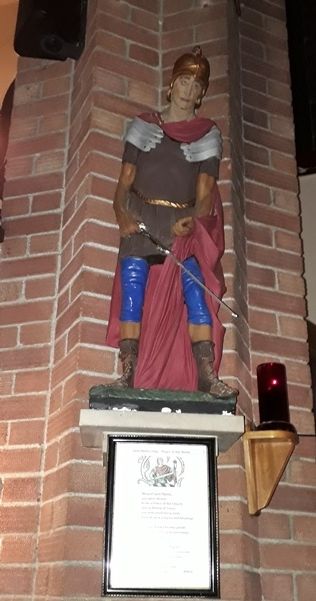Saint Martin
Saint Martin, our Patron
The story that most people know about Saint Martin, portrayed by the statue to him in our church, was one event in a long life devoted to bringing Christianity to the Celtic world.
Martin was born in what is now Hungary at a time of great change in the formation of Christian Europe. The Roman persecution of Christians had recently ended and Rome was in decline. The Emperor Constantine was supporting the Christians although not one himself until his death. The main problem was that now Christians were not being persecuted they had leisure to wonder what being Christian actually meant. Many different interpretations of the scriptures began to emerge with violent disagreement about the nature of God. Our Creed was developed around this time with its emphasis on the Eternal Nature of the Trinity.
Martin as a youth had wanted to be Confirmed into the Christian faith but his father, an old soldier of the Roman army, had other ideas. He sent a brigade of Guards to capture his son and carry him off to serve in his own legion of the Roman army.
It was while serving as a soldier that the most famous event occurred. Outside the gates of the town of Amiens Martin encountered a beggar freezing in the cold winter weather. As a soldier Martin had no possessions of his own, all he had was his stout wrap-around 'army issue' cloak which often served him as a sleeping blanket on the ground at night. Taking his sword he cut the cloak in half giving half to the beggar. That night Martin had a dream in which he saw Jesus wearing the cloak. This was the confirmation he needed to leave the army and follow his will to 'fight' for Christ. Even leaving the army proved difficult. The story goes that the Emperor wanted to give medals or gifts of money to his best soldiers on the eve of a battle. Martin stood in line to receive his and when it was his turn, announced that he wanted to leave the army. This was not well received and Martin was accused of cowardice.
To prove he was no coward, Martin announced that he would stand on the battlefield next day and fight alone. Luckily - or providentially - the battle next day was called off and Martin was allowed to leave. It was then that his real work began. He had always wanted to become a hermit and live alone, and eventually settled not far from Tours at a spot called Liguge where he soon attracted followers who came to live in caves near his hermitage. However he was not to be left in peace and when their beloved Bishop Hilary of Tours died the people of the town wanted Martin to be their new Bishop. Bishops in those days were much more like a local pastor than they are today and lay people had much more say in the election of their bishop. Other local Bishops could have their say, but it was often down to the townsfolk, and they sent a deputation to Liguge.
Now, Martin was very happy living as a hermit, by this time. He had around him the beginnings of a kind of monastic set-up and in fact he has been credited with being the 'Father of monasticism'. The local people then had to resort to deception. One of the leading officials of the town went to Martin and told him that his wife was dying. Martin had developed a reputation for healing and was often in demand to attend the sick and mentally ill, so, unsuspecting he journeyed into town. It was a false call and once the townsfolk had got him into town they would not let him go until he had agreed to become their Bishop.
This was not the end of his career. He set up another monastic community at Marmoutier nearby, and spent the rest of his life preaching, healing and destroying heathen shrines. He travelled many miles on foot or by donkey to spread the faith. He inevitably attracted opposition but his "awe-inspiring spiritual powers" enabled him to spread the Christian faith throughout France and his influence was felt from Ireland to Africa and the East. He died on the eleventh day of the eleventh month in 397. Working up to the last he had answered a call to go down the river to Candes to settle a quarrel. By the time he arrived he was exhausted and the quarrel was hastily patched up so that he could rest. He died a few days later. The story continues that the men of Tours wanted to take the body home for burial, but the men of Poitiers, near his erstwhile home at Liguge wanted the body, so the men of Tours waited until everyone was asleep and smuggled the body out of a window into a boat waiting on the river below to take him back to the place where he had been a Bishop for so long.
Many churches in England are dedicated to him, probably the best known being St. Martin-in-the-Fields in London. Martin's great Abbey at Tours, built to house his relics, was a famous centre for pilgrimages until it was destroyed in the 16th century, rebuilt and destroyed again in the 18th and two streets opened up on the site to prevent it being rebuilt. The twin towers remain and a small basilica was built to hold the excavated remains of the original tomb.
